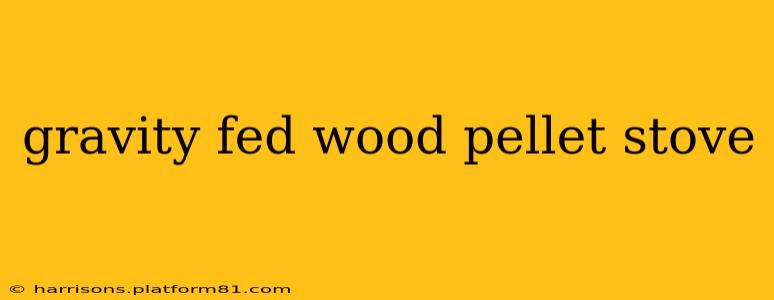Gravity-fed wood pellet stoves offer a unique blend of convenience and efficiency, making them a popular choice for homeowners seeking supplemental or primary heating solutions. Unlike auger-fed systems, which rely on a motorized auger to transport pellets from the hopper to the burn pot, gravity-fed stoves use gravity to feed the pellets. This simple yet effective mechanism often leads to fewer mechanical issues and potentially lower maintenance. This comprehensive guide delves into the intricacies of gravity-fed pellet stoves, answering common questions and providing valuable insights for potential buyers.
What is a Gravity-Fed Pellet Stove?
A gravity-fed pellet stove utilizes gravity to move pellets from the hopper (the storage container for pellets) to the burn pot. Instead of a mechanical auger, a simple chute or gravity-fed system allows pellets to flow downwards to fuel the combustion process. This design often results in a simpler, more robust system compared to auger-fed models, potentially reducing the chances of mechanical malfunctions.
How Does a Gravity-Fed Pellet Stove Work?
The process is relatively straightforward. Pellets are stored in a hopper located above the firebox. Gravity pulls the pellets down a chute into the burn pot, where they ignite and burn to produce heat. The combustion process is controlled by a thermostat, regulating the airflow and pellet feed rate to maintain a consistent temperature.
What are the Advantages of a Gravity-Fed Pellet Stove?
-
Simplicity and Reliability: The absence of a motorized auger often translates to fewer mechanical parts that can malfunction, leading to increased reliability and potentially reduced maintenance.
-
Lower Maintenance: With fewer moving parts, the likelihood of breakdowns decreases, saving you time and money on repairs.
-
Quiet Operation: The lack of a constantly running auger results in quieter operation compared to auger-fed systems.
-
Potential Cost Savings: While the initial cost may be comparable, the reduced maintenance needs might lead to long-term cost savings.
What are the Disadvantages of a Gravity-Fed Pellet Stove?
-
Smaller Hopper Capacity: Gravity-fed stoves typically have smaller pellet hoppers than auger-fed models, requiring more frequent refilling.
-
Pellet Flow Issues: Factors like pellet quality, humidity, and the stove's design can impact pellet flow. Potential issues include bridging (pellets clumping together) or inconsistent feed rates.
-
Limited Range of Models: The number of gravity-fed models available on the market is generally smaller than the variety of auger-fed options.
Are Gravity-Fed Pellet Stoves Efficient?
The efficiency of a gravity-fed pellet stove depends on several factors, including the stove's design, the quality of the pellets, and proper installation and maintenance. While they may not always boast the highest efficiency ratings compared to some auger-fed models, many gravity-fed stoves are still quite efficient and capable of providing substantial heat.
How Often Do You Need to Refuel a Gravity-Fed Pellet Stove?
Refueling frequency depends on the size of the hopper and the heating demands. Expect to refill a gravity-fed stove more frequently than an auger-fed model due to the smaller hopper capacity. You might need to refill it once or twice a day, depending on usage.
Are Gravity-Fed Pellet Stoves More Expensive?
The initial cost of a gravity-fed pellet stove is generally comparable to auger-fed models. However, the long-term cost of ownership might be lower due to potentially reduced maintenance and repair needs.
What are the Best Gravity-Fed Pellet Stoves?
Determining the "best" gravity-fed pellet stove depends on individual needs and preferences. Consider factors like heating capacity, hopper size, features, and budget when making your selection. Research different brands and models to find the one that best suits your specific requirements. Reading online reviews can provide valuable insights from other users.
Conclusion
Gravity-fed wood pellet stoves offer a reliable and often quieter heating solution with potentially lower maintenance. While they might require more frequent refilling, their simplicity and robustness make them an attractive option for homeowners seeking a dependable and efficient heat source. Careful consideration of your heating needs and a thorough research process will help you choose the perfect gravity-fed pellet stove for your home.
